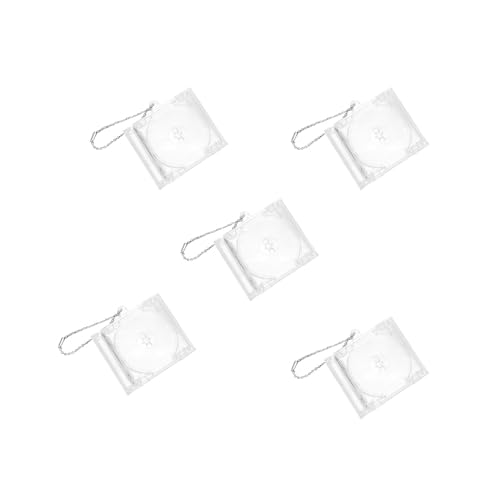| Construction Rating: | starstarstarstar_borderstar_border |
| Flight Rating: | starstarstarstarstar |
| Overall Rating: | starstarstarstarstar_border |
| Manufacturer: | Sunward Aerospace  |
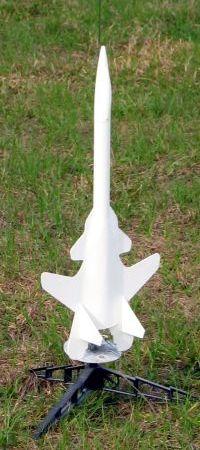
Brief:
The Sunward Sukhoi SU-47 Interceptor is another cool looking rocket that more
closely resembles a fighter jet than a rocket. Like other Sunward kits, it
relies on large pieces of laser cut balsa fins and a series of cardstock wraps
to create its unique styling. There is also an option to build the kit with
either 18mm or 24mm motors.
Construction:
The kit was shipped directly from Sunward and arrived in a cardboard box with
only the kit inside. There was a slight but notable crease in the box. It
wasn't until I actually opened the long plastic bag that I realized that the
single body tube was badly kinked (to the point of being unusable at its full
length) and 2 of the many balsa fins were broken. I emailed Angelo at Sunward
to see how these parts could be replaced.
The kit contains:
- 1 18" BT-56 tube
- 1 molded plastic nose cone with canopy
- 2 large sheets of laser cut balsa fins
- 1 large cardstock sheet with body wraps and fin tabs
- 1 elastic shock cord
- 1 plastic parachute kit (plastic sheet, string, and reinforcement rings)
- 1 18mm motor mount assembly
- 1 24mm motor mount assembly
- 1 waterslide decal sheet
- Instruction manual
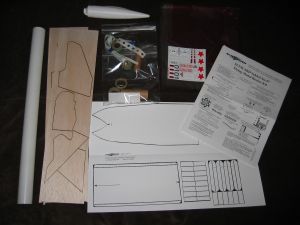
Having already built Sunward's The Liberator, I felt that it flew well but ultimately was underpowered on 18mm C6 motors. Now under new ownership, Sunward apparently is responding to customer feedback on this and has included motor mount assemblies for the builder to use either 18mm motors or 24mm motors. Both MMTs use large paper centering rings (instead of simple fiberboard or cardboard rings). Each motor mount was packaged separately to easily identify which rings went with the correct motor tube. I got a little creative and thought I would really give this rocket some flexibility. I took the 18mm MMT parts and peeled quite a few layers off of the paper centering rings so that they would fit inside the BT-50 (24mm) MMT tube. I then assembled the 18mm MMT per the instructions to turn it into a 24/18mm motor adapter! The smaller motors will have to be friction fitted into the adapter but a wrap of masking tape (over the motor clip) after it is inserted into mount should easily hold the adapter and smaller diameter motor in place during flight.
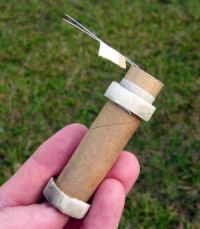 After assembling the motor mount you wish to use,
you come upon a pretty serious "gotcha": You cut out the wraparound
fin marking guide from the instruction manual but it removes a rather important
illustration on the following page showing how to attach the fins to the body
tube. After using the wrap, I taped it back into the manual so I could continue
the build. What really had me scratching my head about the wraparound guide is
that there is plenty of unused room for it to have been printed on the
cardstock sheet with the body wraps and fin tabs.
After assembling the motor mount you wish to use,
you come upon a pretty serious "gotcha": You cut out the wraparound
fin marking guide from the instruction manual but it removes a rather important
illustration on the following page showing how to attach the fins to the body
tube. After using the wrap, I taped it back into the manual so I could continue
the build. What really had me scratching my head about the wraparound guide is
that there is plenty of unused room for it to have been printed on the
cardstock sheet with the body wraps and fin tabs.
Moving on, the fins are laser cut which is especially nice for such a complicated design as this. The large fins are actually made of 3 separate pieces of balsa glued edge-to-edge-to-edge. It wasn't until I was actually gluing them on that I realized that the middle fin pieces are off by ~1/8", creating rough transitions. What makes the misalignment issue especially difficult is that the middle fins are too wide on the forward edge (although I was able to sand them to shape) but too short on the aft edge. I should also mention that the 3 fins on each side are attached singularly and then glued together once on the rocket. If they had been glued together using the wax paper method to join the fins together before gluing them on the body tube, I certainly would have caught this issue. Hopefully this can be addressed in future versions of the kit. Small cardstock tabs are also attached to each of the fins create a noticeably stronger attachment to the body tube. These are also completely covered later on with the body wraps and speed up the build process as you do not (have to) fillet the large fins either.
And speaking of the body wraps, another issue that I feel that Sunward should still work to improve on is the lines on the cardstock wraps. The entire page appears to be drawn by hand with lines entirely too wide to consistently and accurately mark, cut, and place them on the rocket. I pondered the question of do I cut on the outside edge, inside edge, or right down the center of the line? I would have preferred that the lines be more finely made (see Art Applewhite's kits or any of the FlisKit's free paper rockets for a good example of what the lines should be like). I ultimately decided to cut along the outside edge of the line so that I could at least trim the wraps if necessary later on. This inaccuracy did make the wraps more difficult to place properly and sure enough, I had to trim them to shape with a X-Acto knife after attaching them to the rocket. The wraps once applied do add a unique appearance to all of Sunward's kits and are an effective way of creating the fighter jet styling.
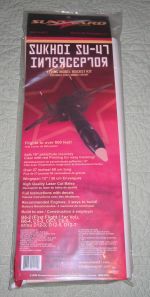 Aside from the body wraps, molded nose cone, and
large paper centering rings, I think one of the coolest features of Sunward
kits are the liberal use of paper fin tabs used in place of traditional
fillets. For a negligible addition of weight, the fin-body tube joints are
strengthened considerably by the overlay of a small strip of cardstock over the
body tube and balsa.
Aside from the body wraps, molded nose cone, and
large paper centering rings, I think one of the coolest features of Sunward
kits are the liberal use of paper fin tabs used in place of traditional
fillets. For a negligible addition of weight, the fin-body tube joints are
strengthened considerably by the overlay of a small strip of cardstock over the
body tube and balsa.
And speaking of the fin tabs, perhaps the most difficult decision I had while building the Sukhoi was gluing on the two fins that were perpendicular to the large fins. The instructions referenced an arrow printed on the cardstock fin tabs to be aligned easily enough with the seam where the middle and aft fins butted against each other but a second point further aft was not mentioned. Without 2 points to ensure that the fins line up perpendicular to the body tube, I had to eyeball it. I got lucky with one fin but the wood glue grabbed quickly stuck at a slightly undesired angle for the second fin. It looks OK from a distance but I am expecting it to be a possible issue during flight. We'll have to wait and see... Some builders might feel that perhaps the only drawback to using these fin tabs is that they visually disrupt the clean lines of the rocket. I suppose a diligent modeler could use a filler to smooth them out though. I did not go to any great effort to hide mine.
A single 2" long launch lug is centered on the belly of the plane-rocket at the aft end of the underside wrap. Again, finicky builders intent on keeping the smooth, clean lines of the rocket will probably want to hide the launch lug inside one of the paper shrouds.
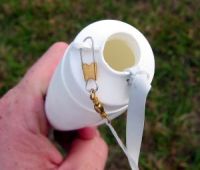 I waited until after painting the rocket before
attaching the all rubber shock cord (just like the ones coming with 2005 Estes
kits) using the tri-fold paper mount on one end and cut a small square hole to
feed the rubber band through in the nose cone. That allowed me to clip the
parachute with a snap swivel to the small hole in the nose cone.
I waited until after painting the rocket before
attaching the all rubber shock cord (just like the ones coming with 2005 Estes
kits) using the tri-fold paper mount on one end and cut a small square hole to
feed the rubber band through in the nose cone. That allowed me to clip the
parachute with a snap swivel to the small hole in the nose cone.
Finishing:
One of the standout features of Sunward kits are their nose cones. They have a
canopy bubble molded into them and are of a heavier gauge plastic (although not
as heavy) as nose cones you would find in larger kits--like ones from
LOC/Precision or PML. The instructions strongly recommend that you wash the
nose cone with mild soap and water to remove any release agents as well as
sanding the nose cone before priming or painting it. Doing that may not be
anything new to an experienced MPR/HPR builder, but I can't think of any other
LPR kits where you need to do that.
Aside from the nose cone, there is little different from the standard finishing techniques for the Interceptor. Diluted Elmer's Fill 'n' Finish was used to seal the expansive fin area, which is still quite a bit despite the multiple body wraps and fin tabs. Allow me to forewarn the folks who don't enjoy sanding (as I am one of them), getting in all of the nooks and crannies across the expanse of balsa fins was challenging at best since it was hard to find a comfortable angle to make the sanding easy while not running the risk of dinging or breaking a fin or tearing one of the wraps. Also, you need to be careful during the priming/painting process to ensure that you get paint inside any of the "intakes" but not cause any runs in the surrounding areas. I started with Krylon white primer. The weather was accommodating when I sprayed the primer but I did have a couple of minor runs. (Better to have runs with the primer than final gloss coats!) I would encourage anyone painting this kit to be patient and take their time or this can turn into a painting nightmare from all of the intakes and unusual fin alignment. I haven't gotten around to the gloss coats just yet, but I will...and when I do, I'll sand everything down with 400 grit sandpaper before spraying the final Krylon gloss colors.
Construction Rating: 3 out of 5
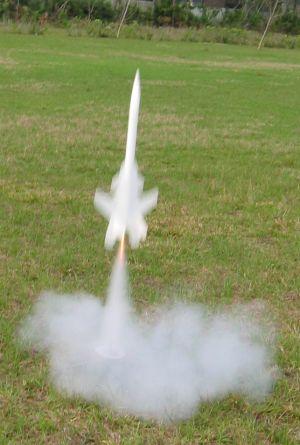
Flight:
The list of recommended motors on the packaging are B6-4, C6-3, C6-5, D12-3,
D12-5, and D12-7. I know from The Liberator that the shorter delays proved to
make for better flights. I just cannot understand the rationale behind
recommending such a wide range of delays for the D12 motors. I would think that
the 3 second delay be much too short and 7 seconds be frighteningly too long.
I'm surprised that there weren't recommendations for the 24mm C11 motors.
I paid my local middle school field a visit to launch the Sukhoi. I had prepped it for the first flight all at home--packed the wadding, chute, and C6-3 motor before I walked out the door. The field was a little windy (5-15mph) but there wasn't anyone around. I parked and set up the pad near the edge of the field upwind so that I could make the most of the field for recovery. I was concerned about the aft fins being in the blast area of the motor but they actually make for a great standoff when I put it on the pad and started the countdown. The rocket lifted off the pad a little on the slow side but still plenty stable with the winds. What was really cool is that the rocket did a belly roll so that it looked like it was flying into the wind and then had a pretty exciting flight because of it wanting to weathercock from the large fin area.
The second and third flights were also on C6-3 motors and complete repeats of the first flight.
Recovery:
The 18" plastic chute needs to be put together by the builder. I'm not
sure what kind of thread that Sunward uses but I have no question that it will
almost certainly hold up longer than the plastic canopy. Even though the rocket
weighs over 4oz, I find that an 18" chute is still too big...at least for
windy days in Florida. I wanted to test the entire kit though so I cut out the
large Sunward logo (~4" diameter) to create a generous spill hole.
Ejection was right at apogee but the chute came out a little on the slow side on the first flight, not opening until the rocket was about halfway down from the 400+ft. It is worth noting that the main body spun horizontally until the chute opened. The chute did open though and the rocket landed within 100yds of the launch pad. Prepping it for the second flight was a slight challenge because of the winds so I rushed stuffing the chute into the body tube. That actually turned out to be a blessing as the chute became tangled in shock cord and never opened. The winds had become a little stronger so even without it opening, it drifted over 100ft further than it had when the chute opened in the first flight.
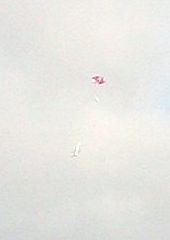 Again with the airframe recovering horizontal, I
decided to go for a third flight but unhooked the chute and removed it
entirely! I'm really glad I did this as there was a huge gust when I pushed the
launch controller button. The rocket with no chute or streamer at all
drifted nearly 600ft from the pad--the furthest from the pad of all 3 flights!
I wouldn't recommend flying this rocket without a chute anywhere but a soft
grassy field on windy days.
Again with the airframe recovering horizontal, I
decided to go for a third flight but unhooked the chute and removed it
entirely! I'm really glad I did this as there was a huge gust when I pushed the
launch controller button. The rocket with no chute or streamer at all
drifted nearly 600ft from the pad--the furthest from the pad of all 3 flights!
I wouldn't recommend flying this rocket without a chute anywhere but a soft
grassy field on windy days.
The C6-3 is definitely the perfect C motor for this rocket. The B6-4 and C6-5 would both have too long a delay. If you really wanted to fly the Sukhoi low, you better make it a B6-2. I would think that either the C11-3 or C11-5 would be about right but I would NOT consider a D12-3 to be an acceptable motor for this rocket. It would just be too soon after motor burnout.
Flight Rating: 5 out of 5
Summary:
The Sunward Sukhoi SU-47 Interceptor is a challenging LPR build that needs some
minor improvements from the manufacturer to make it a fantastic rocket--and it
really would be fantastic! That Sunward includes a 24mm motor mount as well as
the original 18mm motor mount shows that they acknowledge and respond to
customer issues so I do not expect that it will to take care of the Sukhoi's
shortcomings. However, even with these issues, it is a superb flier that can
stay within small fields on B and C motors or should really rip on a D12!
Overall Rating: 4 out of 5
Other Reviews
- Sunward Aerospace Sukhoi SU-47 By Brian Coyle
Brief: The SU-47 is another in the line of 'fighter aircraft' rockets from Sunward Aerospace Group, Ltd. The kit is 27 inches long with a 12 inch wing span and recovers under parachute. This is an interesting model and will make a good impression with the 'X-planes' crowd and garner many 'oohs and ahhs' on the field. Construction: The kit is packaged in a heat sealed, heavy ...
 |
 |
Flights
Sponsored Ads
 |
 |










